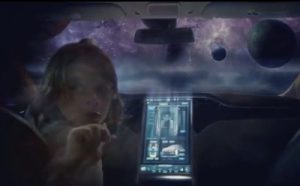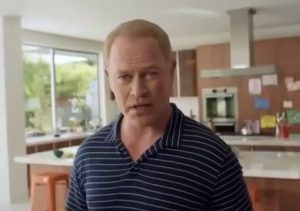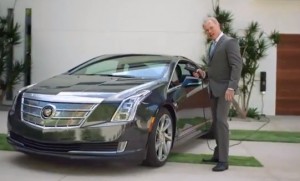 Tesla Motors, which doesn’t have a marketing budget, is benefiting from a creative video spot; the automaker didn’t need to spend one dime on it. In the commercial, “Modern Spaceship,” a little boy imagines himself breaking the speed of light while driving his father’s new car, a Model S. Everdream Pictures, a production company started by recent college graduates, spent $1,500 to make the commercial. So far, Tesla hasn’t paid for it, but may collaborate in the future; Everdream met with Tesla CEO Elon Musk in January to talk about possibilities, and Tesla may hire them for a future project.
Tesla Motors, which doesn’t have a marketing budget, is benefiting from a creative video spot; the automaker didn’t need to spend one dime on it. In the commercial, “Modern Spaceship,” a little boy imagines himself breaking the speed of light while driving his father’s new car, a Model S. Everdream Pictures, a production company started by recent college graduates, spent $1,500 to make the commercial. So far, Tesla hasn’t paid for it, but may collaborate in the future; Everdream met with Tesla CEO Elon Musk in January to talk about possibilities, and Tesla may hire them for a future project.
As for now, Tesla has been streaming part of the video on its Facebook, Twitter, and Instagram pages; and Musk tweeted about the video recently. Tesla Motors sold 18,650 of its Model S electric luxury sedans in 2013 after launching it in the summer of 2012. The Model S sold less units last year than what Nissan Leaf and Chevrolet Volt each experienced, but for its price range – with monthly lease payments ranging from $1,051 for the 60 kilowatt-hour (kWh) version up to $1,421 for the 85-kWh Performance model – those sales figures are quite impressive – especially for an automaker that really hasn’t been around for very long. Tesla has been promoting a less-expensive lease deal to raise consumer interest (more on that later).
Tesla’s brand value has been surprising to observe (as witnessed by its incredibly strong stock prices) given that the auto industry has historically been dominated by a small number of majors with startups going the way of failed 1940s Tucker sedan. Here’s my take on how Tesla Motors has been effectively telling its story…….
Fine product: While Tesla has been getting a ton of press and social media coverage in the past year (with the Hyperloop, Supercharger, and Model S recall fueling most of it), Tesla would have faded by now if its cars had gone the way of the DeLoreon concept car. The Tesla Roadster, built on a Lotus chassis, was impressive being the first production-scale electric vehicle after it was launched in 2008. It was the Model S that turned heads and managed to impress Toyota and Daimler enough to invest in its electric powertrain components. Driving one of them isn’t easy – you don’t get to show up at a dealership and get behind the wheel with a sales rep answering all your questions. You have to show up at a Tesla ride and drive and wait in line to drive one of them; or have a friend who lets you experience what may be the strongest torque ever in a passenger car – and the unique, double-TV-screen dashboard for navigation and apps. There’s been a lot of buzz about its upcoming Model X crossover with double-hinged doors. It’s more affordable Model E compact is scheduled to roll out in late 2016.
Removing range anxiety: Fear of having an electric vehicle’s battery poop out and being stuck on the side of a road has been the major stumbling block for selling a lot more EVs. Tesla has no plans to roll out a plug-in hybrid to alleviate that range anxiety. There are two factors that seem to be helping – one is impressive per charge range. For example, the US Environmental Protection Agency reported that the Model S Performance can go 265 miles on a single charge. Another step forward is coming through with its Supercharger stations that can recharge a Model S faster than any of the CHAdeMO or SAE Combo adapter fast chargers can deliver.
Creative financing: The Tesla Model S has a sticker price ranging from the low $70Ks to the mid-$90Ks depending on the package you choose. Even with federal and state incentives, it’s much more expensive than other EVs and you can find a lot of other quality luxury cars for a much lower price. Tesla has been working with U.S. Bank and Wells Fargo on a lease program that guarantees the residual value during its three-year contract. Tesla says it will have the top residual value of any high volume premium sedan brand – Audi, BMW, Mercedes, or Lexus. Tesla is also pitching the novel idea that the cost goes down to about $500 per month. The argument goes along the lines that you can save $267 per month in fuel costs compared to the BMW 5-Series, and you can subtract more dollars and save more time by gaining access to carpool lanes while driving solo. So, creative marketing and creative financing are paying off.
Leaders with personality: It certainly helps to have a self-made multi-millionaire celebrity like Elon Musk captain the ship. While competitors like GM and dealer networks likely despise him, Musk probably isn’t losing any sleep over it. It also helps to have JB Straubel serve as chief technical officer and Franz Von Holzhausen as chief designer. They’re getting a lot of media attention and respect from car designers – and Straubel and Von Holzhausen tend to be eloquent and analytical about the Tesla technology.
Guerilla marketing: It is quite strange to see the Tesla brand go viral and ubiquitous in such a short period of time. It’s taken Hyundai a lot longer to reverse its negative image and to start winning accolades. Tesla is benefiting from getting strong ratings from Consumer Reports and NHTSA safety ratings (at least before the battery fires last Fall). Its tactics are paying off – with appointment-only ride and drives helping, attention-grabbing retail stores, and sales maneuvers that probably would have impressed P.T. Barnum. An example of this tactic is how good Tesla is at teasing its audience about the upcoming launch of its Supercharger, Model X, etc. Tesla is taking advantage of the digital media/marketing environment where brand value can be increased for free – if done the right way. Getting an email from Musk explaining how the automaker is dealing with the battery fire problem is a very good example of it.
Problem into opportunity: “When written in Chinese, the word crisis is composed of two characters – one represents danger, and the other represents opportunity.” U.S. Senator John F. Kennedy said in a 1959 speech. I chose this quote from JFK on my LeSage Consulting website because it eloquently states the challenge clean transportation is experiencing right now. For alternative fuels and vehicles, every one of them faces huge challenges to break through consumer and fleet acquisitions and building the essential charging/fueling infrastructure. Elon Musk and his team have so far been masterful at becoming well established in the ultra-capital intensive and challenging car business. It also makes for a colorful story of a company delivering cool new technology in this rapidly changing, global economy.


